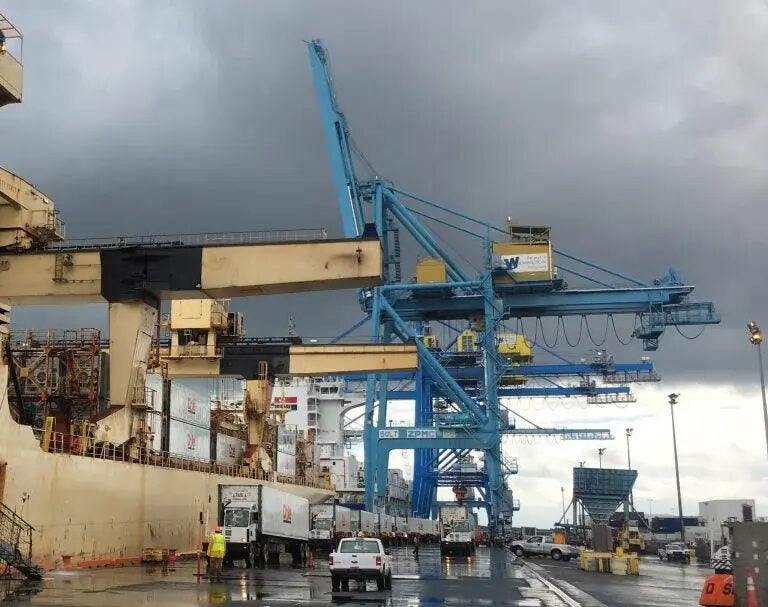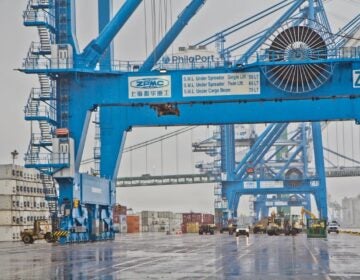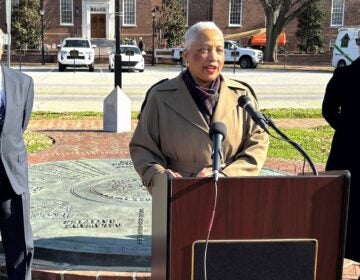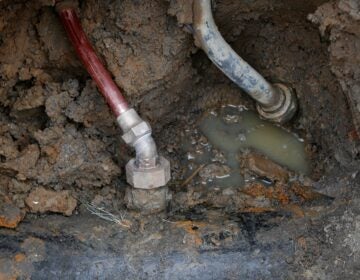‘Game changer’ for Wilmington port: New $635M terminal to bring mammoth ships, thousands of jobs
The existing port has been operational for a century, but it can’t handle the 1,000-foot ships like the one that destroyed Baltimore’s Key Bridge.
Listen 1:57
The existing Wilmington port is known for importing fruit and automobiles but cannot handle mammoth container ships. (Mark Eichmann/WHYY)
From Philly and the Pa. suburbs to South Jersey and Delaware, what would you like WHYY News to cover? Let us know!
Three years from now, at the Delaware River site where the DuPont Co. made billions of pounds of titanium dioxide, massive ships are expected to start rolling in with tons of electronics, clothes, heavy equipment and other consumer products.
That’s Delaware’s $635 million plan to rescue the Port of Wilmington by building a new port two miles north of the one that’s been in operation for a century and is known for handling fruit and automobiles.
The coming Port Delaware North is shaping up as the state’s largest infrastructure project since the construction of the Route 1 highway from Bear to Dover three decades ago. The announcement of the plan comes just a year after the state replaced Gulftainer, the Emirati conglomerate that ran the port for nearly five years but had failed to meet job and expansion promises.
But the Carney administration and the port’s new operator, Massachusetts-based Enstructure, is making even bolder promises for the new terminal in Edgemoor.
Officials say 4,000 construction jobs would be created, generating some $42 million in state and local tax revenues during that period.
Once it opens, 6,000 new jobs are projected, with about half at the port itself for dock and warehouse longshoremen and other employees, and the rest in support roles such as trucking. Those jobs are expected to generate about $40 million in tax revenues annually.
Those totals will be in addition to the jobs and tax dollars at the existing port, which will be renamed Port Delaware South.
And it’s all happening at the same location as DuPont’s former pigments plant, which closed in 2016 after operating for eight decades. The state bought the site the next year, and since then officials have worked to remediate contamination while obtaining the permits needed to construct the new facility for container ships.
Secretary of State Jeff Bullock, who sits on the Diamond State Port Corp., a state entity that bought the port from the cash-strapped city in 1995, stressed that Enstructure will pay for the bulk of the expansion. The state will kick in about $195 million, about 30% of the cost, he said, and federal grants will also be used.
“It’s a very good project for Delaware, both short-term in keeping the maritime sector strong and long-term in terms of our economic future,’’ Bullock said. “Public infrastructure is always a good investment and this will be a good investment as well. The benefits will be felt by Delaware for generations to come.”
Bullock said the benefits of the expansion will “reverberate” around the state and region.
“The economic impact of something like a new port can be felt by everyone,’’ Bullock said. “It’s not just the longshoreman who works on the dock. It’s the truck drivers that come in and out of the facility. It’s the gas station owner. It’s the guy that owns a restaurant or a dry cleaner or any of a number of other businesses that might be utilized by some of the people that benefit more directly from maritime activity.”
Bullock emphasized that port expansion will especially benefit Black families since the majority of port employees are Black, noting that some longshoremen earn upwards of $100,000 a year.
“The port’s been providing high-paying quality jobs that support thousands of Delaware families, and specifically African-American families in our state,’’ he said. “The promise of expanding to Edgemoor is kind of doubling down on that and creating opportunities for many more jobs for people in our state.”
‘It’s going to create thousands of jobs,’ union leader says
Bill Ashe, president of the International Longshoremen’s Union Local 1694, said the port’s survival depends on expansion and the ability to handle the gargantuan container ships that bring products used by U.S. consumers.
“How can we service vessels when we don’t have space to service what we actually have right now?’’ Ashe said. “At some point we will run out of what we have right now and we’ll lose the customers that we have.”
Ashe and Bullock both noted that when a 1,000-foot container ship struck and destroyed Baltimore’s Key Bridge in March, taking that city’s port out of operation, the facility in Wilmington, just 60 miles to the north, could only handle a fraction of the diverted cargo.
“No fault of anybody here, but we couldn’t even handle the big vessels,’’ Ashe said. “First of all, we don’t have enough cranes. We don’t have the capacity.”
Ashe explained that ships which have the equivalent of 10,000 containers that are 20 feet long cannot currently come into Wilmington.
“The most we are doing is 1,200 to 1,300, if that,’’ Ashe said. “And we’re at full capacity. So can you imagine that at some point [fruit importers] Dole and Chiquita say, ‘We want a facility that we can bring bigger vessels in.’ What do we tell them, goodbye?”
Ashe said his local has a current daily work force of 400 to 500 who unload ships, but that number sometimes approaches 1,000 workers during busy periods.
A separate union has workers who run the warehouse where freight is kept temporarily after it is unloaded.
The bottom line, Ashe said, is that the new port terminal to the north should be a major boon.
Beyond the casual workers who could become permanent employees at the docks, Ashe said the port will “need people from all sectors, people that know how to run computers, people who know how to drive cranes.”
“It’s a great opportunity for the state of Delaware. It’s a great opportunity for anybody that wants to start a career working on the waterfront and it’s going to create thousands of jobs.”
A premier port gateway
While Gulftainer was unable to meet its commitment to build a new terminal, Enstructure is financially able to handle the “shovel-ready” project, said Bayard Hogans, who oversees the Wilmington operation. Hogans said design plans are underway and he expects construction to begin next year.
“The project is very much real,” he said. “It is a true public-private partnership and it really is going to transform Delaware into one of the premier port gateways on the East Coast.”
Hogans said the new port on the Delaware River will be able to accommodate ships that need a depth of 45 feet, whereas the existing port, situated downstream but on the Christina River, has a maximum depth of 40 feet.
That means the container ships that are longer than three football fields and supply big box stores and retailers like Amazon, Walmart, Home Depot and Best Buy will finally be able to bring their cargo to Delaware, he said.
“If you are going to a Best Buy or something like that, all of those types of goods that aren’t manufactured here in the U.S., that we consume in this country, come by shipping containers,” Hogans said.
Hogans piggybacked on what Bullock and Ashe said about not being able to pick up the slack for shipments previously destined for Baltimore.
“Without having a deepwater dedicated container terminal, we couldn’t really support that segment there,’’ Hogans said. “This would be a real game changer to support that.”
The project will encompass three phases, with much of the first focused on dredging to 45 feet and waterside construction of a seawall and high deck. Gov. John Carney’s office said the state would seek input from the public before landside construction.
State funds will come from money made available in previous capital “Bond Bill” budgets for large-scale construction projects, including the port project.
The project has bipartisan support in the General Assembly.
House Minority Leader Mike Ramone, a Republican candidate for governor, said the project “will not only result in the productive re-use of a highly visible but vacant industrial site, it also assures future Delawareans have access to maritime careers of the future.”
House Speaker Valerie Longhurst, a Democrat, said the investment strengthens Delaware’s economy. She echoed Bullock in saying that the benefits “will be felt for generations by thousands of Delaware families who will be able to buy a house, send kids to college and improve their quality of life.”
WHYY is your source for fact-based, in-depth journalism and information. As a nonprofit organization, we rely on financial support from readers like you. Please give today.







